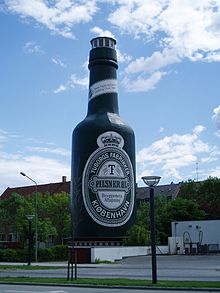Tuborg bottles

Tuborgflasken ( Danish for "The Tuborg bottle ") is a lookout tower built in 1888 in the shape of a beer bottle . The striking, around 30 meter high structure stands behind a petrol station on Strandvejen in Hellerup , a district of Gentoftes in the greater Copenhagen area . The tower was built as an advertising medium for the Tuborg brewery , which was independent at the time and is now part of the Carlsberg Group. The name Tuborg is derived from the Thuesborg country estate , which was built by Jonas Nielsen Thue in Hellerup around 1690.
construction
The Tuborg bottle , which stands on a wooden structure, was subject to several structural changes. Originally the observation tower was equipped with Denmark's first non-human-powered elevator . The elevator system was replaced by a spiral staircase after a short time ; Linen on the outer cladding was replaced with fiberglass fabric . However, the characteristic external shape of the tower was retained.
history
Nordic Industry, Agriculture and Art Exhibition 1888
Tuborgflasken was built in 1888 to designs by the Danish architect Viggo Klein (1850-1913) and was Tuborg's contribution to the Nordic Industry, Agriculture and Art Exhibition in the same year. The exhibition area was part of the Tivoli amusement park , which was located in the immediate vicinity of Halmtorv , today's Copenhagen City Hall Square . The elevator inside the tower, which carried the event guests to the viewing platform, was considered a novelty and modern. The electrically operated light at the top also caused a stir. As a result, Tuborgflasken was not only an advertising medium for the brewery, but also represented the technological and industrial development in the Danish kingdom.
Removals
After the exhibition, the elevator was dismantled and the tower was moved to a new location on the premises of the Tuborg brewery. The company's landmark from then on stood in Hellerup and became part of the Tuborg Pavilion, a rest stop for day trippers and travelers built in the 1880s. For five Øre it was still possible to go upstairs via stairs and enjoy the view. The money for climbing the tower was refunded when a beer was consumed at the adjacent Tuborg pavilion. The pavilion closed its doors in 1925 - after complaints from restaurateurs who complained about competition from their own beer suppliers. A car workshop and exhibition rooms were then housed there until the pavilion was demolished in 1934.
To mark the 100th anniversary, the 30-ton tower was erected again in the center of Copenhagen on Rådhuspladsen in 1988 . The move was linked to the 150th anniversary celebrations of the Danish Council of Industry . Upon his return, the tower was relocated at the Tuborg headquarters.
Considerations of monument protection
The special building supervision ( Det Særlige Bygningssyn ), an advisory commission of the Danish Ministry of Culture , rejected an application for monument protection for Tuborg bottles in 2003 . The art historian Elisabeth Buchwald justified the rejection with too many structural changes that the building had undergone. In the opinion of the building supervision, too little of the original substance of the building had remained intact. The applicant was the State Association for Buildings and Landscape Culture ( Landsforeningen for Bygnings- og Landskabskultur ); Its chairman regretted the decision and described the building as a "very spectacular cultural and historical monument, part of Denmark's industrial history and a landmark in the cityscape of Copenhagen." Although the building authorities did not recognize the "architectural and cultural-historical value", Tuborgflasken has been since 2000 Part of a local plan of the Gentofte municipality , which classifies the observation tower as "highly worth preserving".
Plans by the Carlsberger Marketing Director in 2002 to tear off the bottle and temporarily erect a 30 meter high beer can in its place met with horror at the capital's beautification association . Instead, the building was extensively renovated in 2003.
Web links
Individual evidence
- ↑ a b Politiken : Kæmpetuborg bliver ikke fredet , from March 27, 2003 (Danish)
- ↑ Danske Ølentusiaster: Nyheder fra 2003 , accessed on December 16, 2010 (Danish)
- ↑ a b Den Store Danske : Tuborg , accessed on December 16, 2010 (Danish)
- ↑ a b c Kulturarvsstyrelsen : Unit 05 / 02-2003: 3.2 Tuborgflasken, Strandvejen 50, Gentofte Kommune , accessed on December 16, 2010 (Danish)
- ↑ a b Politiken : Hvem har tegnet Tuborgflasken , September 15, 2006, accessed December 16, 2010 (Danish)
- ↑ a b c d Mette Henriksen: Sommerstemning ved Tuborg . In Lokalhistorisk Arkiv for Gentofte Kommune of February 26, 2009, accessed on December 16, 2010 (Danish)
- ↑ Politiken : Tuborg: Det bliver en dåse , September 25, 2002, accessed December 16, 2010 (Danish)
Coordinates: 55 ° 43 ′ 24 " N , 12 ° 34 ′ 42.1" E
